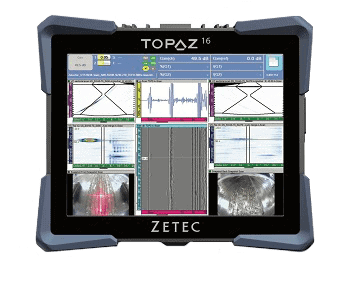UT Fault Detection and Isolation in Multilayer Materials
Industries tend to look for material that can provide sufficient strength and toughness to ensure the integrity of a structure. Multilayer composites and laminates of metals fulfill this need for industries like aerospace, construction, automotive, and power generation through their excellent strength, corrosion resistance, and low coefficient of thermal expansion.
However, to leverage the full potential of these multilayer materials, it is important that the bonds between the consecutive layers are intact, and the component as a whole is able to provide full mechanical strength. Any flaws or discontinuities between the layers can compromise the quality of the component and weaken it. On the other hand, detection of flaws on such multilayer material can be especially challenging. Inspection using ultrasonic testing (UT) technology is effective in fault detection and isolation for material integrity validation.
Understanding the Nature of Flaws in Multilayer Materials
Multilayer materials, like composites or laminates, combine the properties of two or more materials to operate and perform a particular operation as a singular entity. The use of different material layers works to enhance the properties of the base material. However, in the manufacturing of composites, there is a possibility that flaws can occur. The most prevalent type of flaws may include:
- Delamination
- Poor bonding between the layers
- Foreign inclusions
- Porosity
- Cracks
These flaws can occur in the material during the operation due to extreme temperatures, stress, fatigue, and dynamic loads, and the implications can be severe. To further complicate things, the attributes and locations of these flaws are difficult to detect because of the multiple layers. The non-homogeneity and anisotropic nature of the composites also add to the challenges of detection and identification.
There are various non-destructive testing (NDT) technologies like eddy current or acoustic emission testing that specialize in detecting specific kinds of flaws for select materials. However, in this case, UT, specifically phased array ultrasonic testing (PAUT), can prove to be ideal for early fault detection and isolation for multilayer material inspection.
Phased Array Ultrasonic Testing for Fault Detection and Isolation
Phased array ultrasonic testing is ideal for pre- or in-service material inspection to identify flaws through different types of materials. This advanced ultrasonic inspection method transmits a high-frequency beam through the transducer into the inspection component, the reflection of which can be examined for any deflection or variation, usually the indication of a flaw in the material. Across different material layers, the wave propagation can be different. But PAUT enables the identification of flaws through analysis of change in acoustic impedance across each material layer. This is helped by the pulse control and beam focusing ability which facilitates penetration to greater depths and improves the sensitivity of flaw detection.
An inability to identify or visualize a flaw is a major concern in such multilayer composites and laminates. Exposure to dynamic load can make it a possibility for further layers to be subjected to cracks and delamination. With the help of PAUT instruments, probes, and software, technicians can visualize the hidden layers, detect the flaws and localize them. In cases where PAUT is utilized as preventive maintenance, fault detection and isolation can be made easier with recurring monitoring of the system, observation for any variations, locating the flawed point, and characterization of the flaw. This way, an ultrasonic inspection can easily facilitate the test for material strength, consistency between layers, and bonding between the material layers.
Ensuring Multilayer Material Integrity with Ultrasonic Testing
Ultrasonic testing has proven itself to be ideal in terms of accuracy and reliability in flaw detection. While some NDT methods provide surface-level flaw detection, for composites and laminates, PAUT can inspect at different depths and inclinations across multiple layers with the same sensitivity to flaw detection. This ability to identify flaws of complex nature and assess material strength across multiple layers is highly advantageous for industries where UT can be leveraged as a quality control measure to ensure the integrity of the structure.
Zetec has been a leading provider of high-performance NDT solutions for decades. Our eddy current testing solZetec is a leading ultrasonic testing equipment provider for a wide range of industries and applications. To find the NDT equipment which best suits your inspection needs, contact us today!

Zetec’s designers are industry-leading experts in ultrasonic and eddy current technologies, and we can help you navigate any of our NDT testing solutions or devices.

